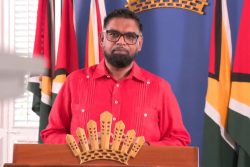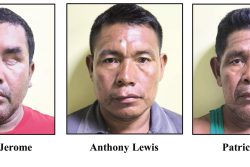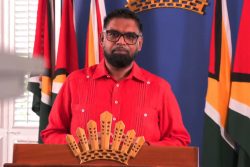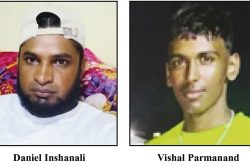The deaths of two men at Mahaicony on Wednesday have brought into sharp focus two serious matters that successive governments have failed to address.
Roger Erwyn Pierre, a 55-year-old mentally ill man and drug addict was shot dead by the police while he was attacking another man. The other man Terrence Williams, who had been trying to subdue Pierre, also died from wounds he sustained from Pierre’s knife and perhaps also from the gun of a policeman.
The rampage by Pierre lasted for some time during which several other men were injured. It also moved some distance from Huntley to Airy Hall. All along the way members of the public were exposed to dangers and some did try to intervene to defuse the situation.
The first major issue is the failure by the police to bring the situation under control without the undue use of lethal force. There has been much fanfare by President Ali and others in the government over the prowess of the Police Academy. A lot more work clearly has to be done at the Academy on how to take control of situations like the one at Mahaicony without the use of lethal force.
The police said in a statement on Wednesday that investigations revealed that at approximately 9:30 am, Pierre stabbed 63-year-old Laldat Tooknauth, a resident of Huntley. Following the assault, Pierre fled the scene while Tooknauth was transported to the Mahaicony Hospital and subsequently transferred in critical condition to the Georgetown Public Hospital.
Then at around 10:30 am, officers from the Mahaicony Police Station received information that Pierre was at Novar School Dam, armed with a knife and causing panic in the area. A team was dispatched to the location and upon arrival, they spotted Pierre on Dundee Public Road, brandishing the knife. When the officers attempted to disarm and apprehend him, he resisted aggressively, the police said.
During the confrontation with police, Pierre was shot in the left foot. Despite his visible injury and police orders to drop the knife, he continued to walk down the public road. As he approached the neighbouring village of Airy Hall, bystanders attempted to persuade him to surrender. However, Pierre’s aggression escalated and the police said that he threw glass bottles and sand at both officers and nearby residents. He then concealed the knife in his waistband, picked up a steel rod from a nearby construction site, and attacked a 69-year-old resident, Lambert Nunes, inflicting a wound to his left hand. Continuing north along a cross street, Pierre was pursued by police and residents attempting to restrain him.
Williams then successfully tackled Pierre to the ground amidst the ongoing chaos. During the struggle, Pierre managed to seize the knife from Williams and attacked him, repeatedly stabbing him in the head and other parts of his body.
In response to the situation, the police said that two of its officers fired multiple shots at Pierre, rendering him motionless. Both Williams and Pierre were subsequently taken to the Mahaicony Hospital, where Williams succumbed to his injuries during treatment, while Pierre was pronounced dead on arrival. What appeared to be gunshot wounds were found on both bodies.
By their own, account the police had two opportunities to subdue Pierre without killing him. He was shot in his foot at Novar but was apparently able to still defy the police and continue his hobbled walk of terror. Why were the police unable to wrestle him to the ground at this point?
It took the public-spirited Williams who succeeded in bringing Pierre to the ground only for the latter to gain access to his knife and inflict serious wounds. It was at this point that two policemen opened fire without apparent concern for the lives of either man and both succumbed. Why at this stage were supposedly well-trained policemen unable to bring this confrontation to an end without the loss of life?
There must be a full investigation of this matter and hopefully the Guyana Police Force will cooperate fully with the Police Complaints Authority (PCA). It must be pointed out that for several years now the PCA has lamented in annual reports that the police have been recalcitrant in relation to cooperating with the PCA and enabling an independent probe of cases where the police have been involved in fatal shootings.
The other area of gross failure relates to the care and treatment of persons with severe mental health problems and drug addiction. Pierre’s family has acknowledged that he abused drugs and had to be kept on medication. He was clearly not on medication on Wednesday and whether the family’s responsibility or other, the larger society must also be held accountable. The family has recounted difficulties in the well-known problem of having persons like Pierre committed by the court to institutions where they can possibly get the help they need. Ironically, just this week, the Supreme Court of Judicature announced plans for a mental health court. As a first exercise it might be instructive for the court to reconstruct the points of contact of Pierre with the legal system and how he might have been addressed differently and how these cases will be handled going forward.
It also behooves the Ministry of Human Services which speaks volubly about its social services to engage with its mental health unit and services in the regions as to why cases like that of Pierre are not better addressed and simply left to families. Was anyone from the Ministry of Human Services ever in contact with Pierre or his family? If not, considering the multifarious expeditions all around the country the ministry should examine why it had not been in contact.
Does the ministry invite families with relatives who might be schizophrenic or exhibit other serious mental health problems to get in touch if there is an emergency like the case on Wednesday? Is there a hotline?
The Finance Minister boasted during yesterday’s budget presentation that there will be a new mental health hospital. It means little if persons like Pierre remain beyond the reach of the care necessary.
How about the need for amendments to the law to enable persons to be more easily committed to mental institutions in cases where this is necessary?
These two deaths pose searing questions in this `fastest growing economy’ and citizens are entitled to answers from the judiciary, the police and the various state social services.








